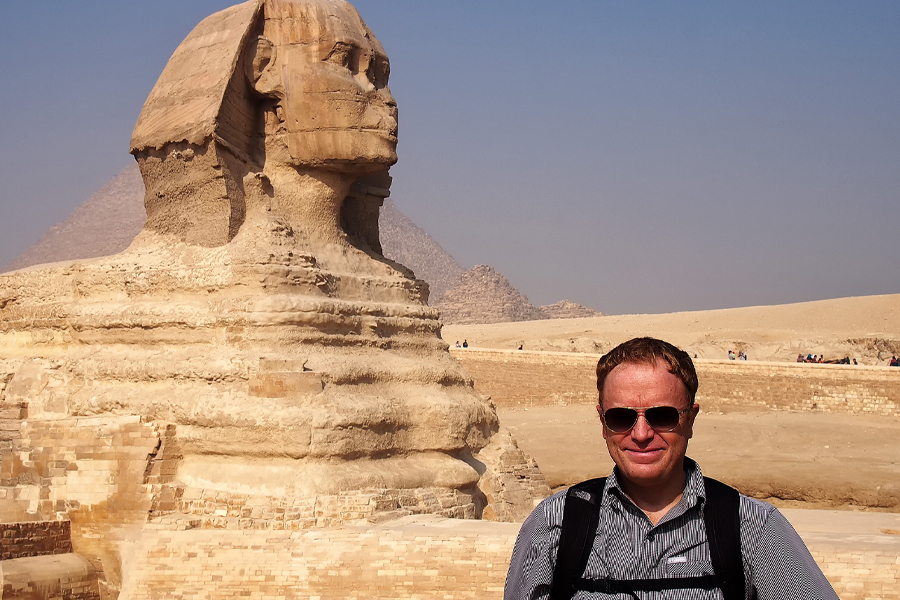The Great Sphinx has to be mentioned when talking about large sculptures. The whole thing is almost 66 feet high and has a human head on top of a lion’s body. This beautiful statue is nearly 240 feet long, and a royal headpiece sits on top of the human head of the Sphinx.
This colossal figure stands out in the valley where Khafre’s temple is. And the likeness to the Egyptian pharaoh Khafre is striking. Because of this, the Great Sphinx is thought to be from the 4th Dynasty, and Khafre wins because he is more likely to have owned the Sphinx.
Some researchers, however, think that Khafre’s older brother Rejedef was the mastermind behind the structure. As a possible tribute to his father, Khufu, Rejedef may have constructed the Sphinx. Also, others say the Great Sphinx resembles King Khufu rather than Khafre.
Where to find the Great Sphinx
Giza, Egypt, on the western bank of the Nile, is home to the Great Sphinx, one of the structures of the Giza pyramid complex. The famous Sphinx sits on the Giza Plateau’s back to the east. Aside from the pyramids, this is one of the earliest ancient Egyptian monuments we know about. The Great Pyramid is one of the best-known parts of the Giza Necropolis and is also an essential part of the history of architecture.
Describe the Sphinx:
The Sphinx is a legendary creature with a lion’s body and a person’s head. Because of this, it is an essential part of Egyptian, Asian, and Greek mythologies. The Sphinx was seen as a magical guardian by the ancient Egyptians. The monster usually looks like a guy with a pharaoh’s crown on his head.
History:
The Great Sphinx of Giza is a single-piece statue carved out of the plateau’s granite. Around 2500 BC, the royal pharaoh built the second pyramid at Giza. The rocks in front of the statue were shaped into a temple that goes all the way around her body. During the Eighteenth Dynasty in Egypt, the Sphinx was called both the “Mountain of the Necropolis” and the “Horizon of the Horizon.” This name stands for the God of the rising sun.
In terms of how they are put together, many scholars have found similarities between the Sphinx and the pyramids. They thought that the Great Sphinx might have been a sign from God. These temples use the sun’s power to bring Khafre back to life.
The Sphinx was built:
It was thought that the monument took about three years to build. About one hundred people could be hired each year. Stone hammers and copper chisels were used to finishing the statue.
This monument was not put together in separate parts. The Great Sphinx of Giza is made from a single block of limestone. Workers had to dig a quarry around the Giza plateau to get to the limestone.
From what we know, this statue was meant to be a lot bigger than it turned out to be. But the workers ran out of the building. In archaeology, scientists have found vast slabs of stone that were never polished, and Toolkits that had been left behind and found nearby prove this.
Historians have come to the following conclusion based on the writing they found on the Sphinx’s walls. Lehner’s digs show that the Egyptian pharaoh did not enslave people.
There are stories about the Great Sphinx.
The Necropolis stopped being used sometime around the First Intermediate Period. The wind-blown sand came up to the shoulders and covered the vast body.
Around 1400 BC, people were first known to have dug into the ground. This effort is shown on a dream stele discovered between the Sphinx’s powerful paws. According to the stele, Amenhotep II’s son, Prince Thutmose, slept close to this formidable sentry. The statue was unhappy with the clutter in the dream. Because of this, the Sphinx made a deal for a reasonably low price. The prince’s rise to power as pharaoh will depend on how well the Sphinx is fixed.
The young prince took this advice to heart and, with the help of his crew, dug up the forepaws of the Sphinx. On an altar between them is a stele with the meanings of dreams. It’s still not clear if the dream came true or not. Even so, Thutmose IV, the Pharaoh, was made a prince. To do this, he also taught his people about the religion of the Sphinx.


0 Comment